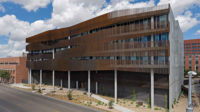My last several columns have looked at code requirements for resilience and government plans to enhance resilience. These efforts focus on the “big picture” — overarching plans and guidelines meant to move resilience forward on a broad front and considering multiple hazards and scenarios. However, it is also worth taking a step back to specific hazards and applications. One way to do this is to look at case studies for various projects. One such case study, published in 2019 by the Rutgers Center for Green Building, looked at how people responded to a heat wave.
A study performed by Rutgers examined how residents of three Housing Authorities of Elizabeth, New Jersey, responded to a heat wave. One property, let’s call it (A), contained 421 units in 15 three-story walk-ups with new roofs. The second property, property (B), consisted of one 11-story building with 121 units and extensive upgrades, while the third property, (C), was a LEED Gold, 30-unit senior living facility with all units having central air conditioning. The research used indoor and outdoor sensors to measure the air quality and structured interviews with the residents to determine how they responded to the heatwave.
The heat avoidance measures utilized by the residents varied with the building site. All three sites had at least 50% of the residents adjusting fans, closing windows, using the air conditioning, and leaving the apartment. Residents in site A took additional steps, such as adjusting their clothing and avoiding using the oven, stove, or candles. Only a small percentage, if any, of the residents at the other sites (B and C) used these coping strategies.
Several hypotheses were proposed by the researchers, all of which were at least partially supported by the results. First, it was suggested that residents would alter their behavior in response to a heatwave, and all residents were found to change their behavior in at least some ways. However, the physical and social conditions of the residents constrained their actions due to limited funds, mobility problems, and other issues. The apartments and building systems were found to constitute the primary environment for the residents, but constraints related to the building systems limited the residents’ options for response. For example, while almost all residents closed their windows and use the air conditioning where available, not all buildings had central air conditioning, and the building envelopes varied greatly between buildings.
The results highlight the fact that the building residents are the primary drivers of the response to events, such as a heatwave. As such, they are extremely dependent on the ability of the building systems to perform adequately during the event. This is particularly true when the residents are extremely vulnerable to the effects of the event, limited in mobility, or have financial constraints that may limit their use of building systems. In addition to designing a building with energy-efficient systems and envelopes, there are some additional steps identified in the study that might be taken, including providing shaded outdoor space, creating vegetated roofs, designing a cool roof, and providing energy-efficient landscaping.
The use of case studies, such as the Rutgers Center for Green Building, can help provide valuable information about how residents actually respond, allowing for better informed decisions regarding resilience investment. One aspect of resilient design the case study does not address is the tradeoff between providing both passive and active systems that are capable of mitigating the effects of extreme events and the need for cost-effectiveness for more normal operating conditions. The decision on how much “extra” to invest to address extreme events is a dance between the initial costs, normal operating costs, and true life cycle costs. If a building is damaged or becomes uninhabitable due to an event, the cost in either repairs or lost revenue can dwarf the initial investment in a more resilient design. This tradeoff question should become easier when a vulnerable population is housed in a facility, but this is not always the case. If enhanced resilience is the goal, it’s not enough to consider the hardware of building design. A designer must also consider the actions of residents and how those can change with design decisions.





